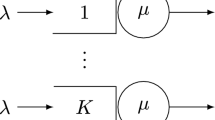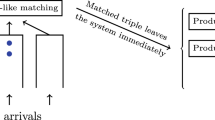Abstract
This paper considers a class of two discrete-time queues with infinite buffers that compete for a single server. Tasks requiring a deterministic amount of service time, arrive randomly to the queues and have to be served by the server. One of the queues has priority over the other in the sense that it always attempts to get the server, while the other queue attempts only randomly according to a rule that depends on how long the task at the head of the queue has been waiting in that position. The class considered is characterized by the fact that if both queues compete and attempt to get the server simultaneously, then they both fail and the server remains idle for a deterministic amount of time. For this class we derive the steady-state joint generating function of the state probabilities. The queueing system considered exhibits interesting behavior, as we demonstrate by an example.
Similar content being viewed by others
References
L. Kleinrock,Queueing Systems, Vol. 2: Computer Applications (Wiley-Interscience, New York, 1975).
J.A. Morrison, Two discrete-time queues in tandem, IEEE Transactions on Communications, Vol. COM-27 (March 1979) 563–573.
A.G. Konheim and B. Meister, Service in a loop system, J. Assoc. Mach. 19 (1972) 92–108.
M. Sidi and A. Segall, Two interfering queues in packet-radio networks, IEEE Transactions on Communications, Vol. COM-31 (Jan. 1983) 123–129.
J.D.C. Little, A proof of the queueing formulaL=λW, Operations Research 9 (1961) 383–387.
E.T. Copson,Theory of Functions of a Complex Variable (Oxford University Press, London, 1948).
G. Fayolle and R. Iasnogorodski, Two coupled processors-the reduction to a Riemann-Hilbert problem, Wahrscheinlichkeitstheorie (1979) 1–27.
M. Eisenberg, Two queues with change over times, Operations Research 19 (1971) 386–401.
M. Eisenberg, Two queues with alternating service, SIAM J. App. Math. 36, No. 2 (April 1979) 287–303.
P. Nain, Analysis of a two-node ALOHA network with infinite capacity buffers, preprint, 1986.
Author information
Authors and Affiliations
Rights and permissions
About this article
Cite this article
Sidi, M. Two competing discrete-time queues with priority. Queueing Syst 3, 347–361 (1988). https://doi.org/10.1007/BF01157855
Received:
Revised:
Issue Date:
DOI: https://doi.org/10.1007/BF01157855




